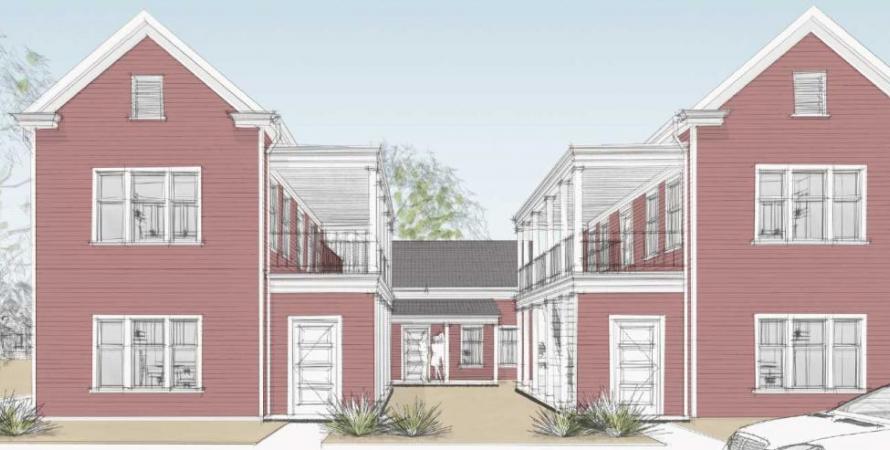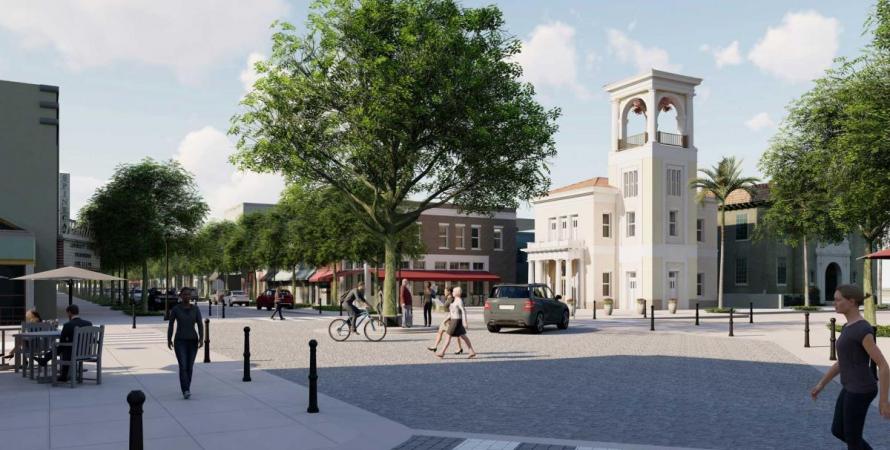The new Bastrop Building Block Code (B3) requires a street grid for new development in the growing Texas city of nearly 10,000 residents, located about 30 miles from Austin. Since B3’s adoption in November of 2019, multiple creative and innovative projects have used the code, which was recognized this year by CNU’s twentieth annual Charter Awards.
The code focuses on the most essential elements of city building, using limited regulations to promote timeless, adaptable places that respond to the natural environment. Fiscal sustainability is also a key goal of the code.
“This is a great version of a ‘smart code,’ with enormous flexibility to do a good job,” says urban designer Geoff Dyer, who chaired this year’s Charter Awards jury. “And the code does a great job of eliminating the bad stuff.”
The city has sustained five significant floods in the last decade, and stormwater issues motivated the creation of the code. City leadership identified the late 20th Century land-use regulations as the root cause of the flooding. The new street grid and code are geared to creating flexible solutions for stormwater management—and adapting the street network to the natural environment. Bastrop is one of the first municipalities in America to re-establish a street grid pattern of development citywide, covering nearly 6,000 acres and thousands of individual properties.
The B3 Code is organized by building type, street type, and place type. The mix and types of buildings and uses can vary block by block and street by street. The 330-foot-by-330-foot street grid, based on the city’s historic pattern, establishes the framework for the B3 Code, which does not have minimum lot standards. This characteristic entices builders to produce a wide range of housing types, with varied sizes and costs.
While the code was drafted, a moratorium was placed on development, which lasted eight months. The moratorium ensured that new development detrimental to the city would not get approved while leaders established a more sustainable framework for growth. The public engagement process was thorough and transparent. The feedback was consistent—residents wanted a code that was streamlined, easy to understand, and ensured that new development would not contribute to future flooding problems. Residents also expressed concerns about the lack of connectivity between developments and limited routes across town.
The project team began by mapping the “DNA” of the city—extracting the numerical data and creating models that showed what fiscally sustainable development looks like. “The new code is directly based on the portion of the city’s built environment people already know and love: Downtown Bastrop,” notes the project team. Foundational elements of the new code include a return to a street grid pattern of development, the integration of diverse building types and an emphasis on walkability, and maintaining a quarter-mile radius for housing, work places, and public amenities. The walkability that is written into the code will ensure the creation of economic and social activity that make street life thrive. Moreover, the code is design to reduce construction and ongoing maintenance costs—a win-win for developers and residents alike.
The code supports property rights by loosening regulations in the second and third layers of a lot (the rear) and by defaulting to the current International Building Codes for all building standards and setbacks. The code promotes fiscal sustainability through the formation of local urban cores, mixed commercial and residential uses, and a variation in housing types to include small-scale multifamily. To incentivize infill development in established neighborhoods, any parcel under 3.2 acres and under four lots, with proper zoning, will take part in a development-by-right administrative review process.
Bastrop’s natural environment is unique—the city sits at the confluence of the coastal plain, the Texas hill country, and an ecologically significant pine forest. But the challenge is common to communities across the US. Many cities and towns are facing similar sustainability issues, and B3 is a model for how to build and invest in infrastructure in an ecologically sound way.
“We started this process last summer to address flooding in Bastrop and create a roadmap for responsible development that honors our authentic past and prepares for our sustainable future,” says Mayor Connie Schroeder. “Like many cities and towns across the country, Bastrop has been faced with tough decisions related to significant growth combined with aging infrastructure and outdated land-use regulations. With Building Bastrop, we are controlling growth rather than letting growth control us.”



